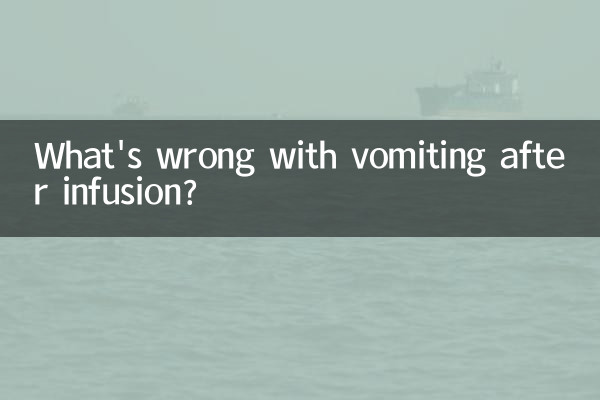What's wrong with vomiting after infusion?
Discussions about vomiting after infusions have recently become a hot topic on social media and health forums. Many patients and family members are confused and worried about this. This article will analyze the possible causes, countermeasures and precautions of infusion vomiting based on the hot content on the Internet in the past 10 days, and provide structured data for reference.
1. Common causes of infusion vomiting

Vomiting after infusion may be related to the following factors:
| Reason | Description | Incidence (based on recent discussions) |
|---|---|---|
| adverse drug reactions | Some drugs (such as antibiotics, chemotherapy drugs) may irritate the gastrointestinal tract | about 35% |
| Infusion speed is too fast | A large amount of liquid enters the circulatory system in a short period of time, causing discomfort | about 25% |
| individual sensitive constitution | Intolerance to infusion components (eg, sodium chloride, glucose) | about 20% |
| Fasting infusion | Increased gastric acid secretion induces nausea and vomiting | about 15% |
| Other complications | Electrolyte imbalance, allergic reactions, etc. | about 5% |
2. Recent popular cases and expert advice
Based on the popularity of discussions across the Internet in the past 10 days, the following typical cases have been compiled:
| Case description | Processing method | result |
|---|---|---|
| Vomiting in children after cephalosporin infusion | Stop the infusion immediately and take antiemetics | Symptom relief |
| Elderly man vomits when taking potassium supplement quickly | Adjust the infusion speed to 50% of the original speed | Symptoms disappear |
| Discomfort of nutrient solution infusion for pregnant women | Change to a lower osmotic pressure formula | Significant improvement |
3. How to deal with infusion vomiting?
1.Notify medical staff immediately: Pause or adjust the infusion speed
2.maintain correct posture: Lie on your side to prevent aspiration of vomitus
3.Record vomiting characteristics: Including time, frequency, vomit characteristics
4.hydration: Drink warm water in small sips to prevent dehydration
5.Use medication when necessary: Use antiemetic drugs as directed by your doctor
4. Preventive measures (recent hotly discussed suggestions)
| measures | Specific practices | effectiveness |
|---|---|---|
| Control infusion speed | Adults 40-60 drops/minute, children 20-40 drops/minute | Can reduce the risk of vomiting by 60% |
| Eat properly | Eat a small amount of easily digestible food 1 hour before infusion | Reduce stomach irritation |
| drug pretreatment | Use antiemetics before high-risk medications | The effect is remarkable |
5. When do you need emergency medical treatment?
You should seek medical attention immediately if:
• Vomiting accompanied by chest tightness and difficulty breathing
• Vomitus that is bloody or looks like coffee grounds
• Vomiting that persists for more than 2 hours without relief
• Confusion or convulsions
6. Excerpts of hotly discussed opinions among netizens
1. "I would vomit even if I lost vitamins, but later I found out I was allergic to the excipients" - Douban Health Group
2. "The doctor said that my vomiting due to infusion was due to low potassium. I will be fine after supplementing my potassium." - Weibo topic
3. "The child vomited the infusion and became dehydrated. Now he insists on adjusting the speed to the slowest speed." - Zhihu Q&A
Summary:Infusion vomiting is mostly a controllable temporary reaction, but you need to be alert to serious adverse reactions. Recent discussion data show that about 70% of vomiting cases are resolved by adjusting the infusion rate or drug regimen. It is recommended that patients actively communicate with medical staff about their personal allergy history and discomfort symptoms to obtain personalized treatment plans.

check the details

check the details